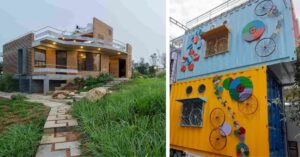How Architecture Can Help India’s Heat Action Plans Combat Heat Stress
Heat waves have killed 20,615 people in two decades. The government has laid out ‘Heat Action Plans’ to combat this but is that enough?

“My family finds it difficult to sleep during summer. Even though we have a fan, it blows hot air from the sheets which gives us a headache. I feel giddy during the summer and my children develop heat boils and rashes,” shares Ratna from Bengaluru.
Ratna is one of the numerous people battling inhumane heat stress conditions under poorly ventilated, heat-absorbing tin-roofed house structures of India’s marginalised urban settlements. While most of us reading this might not have a first-hand experience of what it feels like to live under a tin-roofed heat-absorbing house, the peril of heat stress might not seem as alien today as it may have once felt. Intense heat episodes are excluding no one, not just locally but also globally in recent times.
Heat waves killed over 20,615 people from 2000 to 2020 and are the second deadliest natural force in India, after lightning.
Temperatures even touched the 40 degrees Celsius (°C) mark in March 2022 across large parts of central and western India. ‘Beating the Heat: A Sustainable Cooling Handbook for Cities’, a guide published by the UN Environment Programme (UNEP) in 2021, warns that cities worldwide could warm up by 4°C on average by 2100. This is more than double the 1.5°C goals set under the Paris Agreement — because of the urban heat island effect.
The high density of buildings, asphalt and concrete, and minimal vegetation create extra sweltering ‘heat islands’ in cities. This is exacerbated by waste heat from energy-guzzling air conditioners, exhaust from vehicles and industrial processes and heat reflected from glazed façades.
A study conducted by the environment group World Resources India (WRI) mapped the October 2020 heat and the risks attached to it. It revealed that informal settlements in Mumbai consisting of metal roofs and poor ventilation were 5 degrees warmer than the formal housing in the vicinity. With outside temperatures soaring, these homes become unbearably hot to inhabit and often do not cool down adequately till midnight, augmenting the societal injustices the owners of these homes already battle with.
As a response to the increasing heat stress, governments have started formulating Heat Action Plans (HAP). HAPs are primarily designed as adaptation plans with suggested preventive measures and protocols to battle increasing occurrences of heat waves and escalating temperatures.
According to the IMD, a heat wave occurs when the temperature crosses 37°C in the coastal areas, 30°C in the hills and 40°C in the plains.
In India, Odisha has been the first state to have a HAP in place as early as the year 2000, following the 1998 death toll due to severe heat, with intermediate revisions to the plan to deal with ballooning heat conditions. The HAP movement however gained momentum only after 2013 with the Ahmedabad HAP, which was instrumental in influencing other states, cities and districts. As of 2022, 17 states in India have already declared heat wave conditions and warnings which has catalysed them to work on their HAPs. The National Disaster Management Authority (NDMA) has developed a national framework for the plans in addition to establishing guidelines and supporting capacity building at the state level.
At an overarching level, the HAP framework focuses on:
- Establishing early warning systems and inter-agency coordination
- Capacity building/training programs for healthcare professionals
- Public awareness and community outreach
- Collaboration with non-government and civil society.
The framework makes it incontestable to suggest rewording the presently titled ‘Heat Action Plan’ to ‘Heat Reaction Plans’. While the HAP framework reflects cautionary and responsive mechanisms with reactive and adaptive connotations, it fails to take active steps towards addressing vital aspects of the built environment which have a colossal impact on heat stress conditions. This lacuna exists even though one feature of the early warning systems in the existing HAP framework recommends staying indoors at certain hours during peak temperatures. The burning question is: Are the indoors equipped to deal with heat stress with outdoor temperatures soaring as high as 40°C?
Heat adaptation and mitigation
A glance at our cities and built spaces today will indicate an amalgamation of marginalised settlements, middle-income and affluent housing which vary in their social, spatial and structural characteristics. Marginalised settlements are characterised by both overcrowding and cramped spaces built with temporary makeshift materials such as scrap metal, and tin, which are heat-emitting materials, with minimal or no access to daylight or ventilation.
According to the 69th National Sample Survey report, the poorest households in urban areas have only 8 sq m of housing space per person. This is drastically deficient compared to the minimum 12 sq m recommended by the World Health Organisation to ensure the health and well-being of a person. Contrastingly, affluent and middle-income housing are either over spacious or sufficiently spaced and mostly constructed with heat-trapping concrete and ill-considered ventilation design. While air conditioners have become a means to achieve thermal comfort in built spaces for affluent and most middle-income populations, marginalised populations who rely on fans and bear the brunt of power cuts are rendered most vulnerable to increasing temperatures. This glaring inequity in urban areas demands scrutiny, given the fact that a typical one-tonne split AC in India consumes as much power as 25 ceiling fans. It is non-negotiable vital to ensure more sustainable, affordable and just alternatives to meet human cooling needs on our heating planet. Architecture is an undervalued gateway to achieve this.
Can you build a gorgeous #ecofriendly house in 125 days? Mahesh Krishnan did so with just Rs 18,500 and some #YouTube lesson.
Made of #clay and palm leaves, this #sustainable home stays naturally cool in summers.#NaturalBuilding #MudHome #Bengaluru #Architecture #Organic pic.twitter.com/f1UHHD6Txk— The Better India (@thebetterindia) August 9, 2022
A vital architectural objective is to design indoor living conditions that are responsive to and regulate the micro-climate to ensure thermally comfortable and habitable conditions, by using locally available resources as building materials. Traditional houses were successful in doing this without air conditioners or other insensitive mechanical means of ventilation. Vernacular architecture thrived on passive, nature-based ventilation design and local materials which were innately resilient to the micro-climate of the region. Houses of mud with small punctures or latticework openings in Rajasthan, houses of stone in North India, houses of bricks and wood with large windows in South India in addition to thick-walled houses in hotter regions and thin-walled structures in coastal regions, supported meeting cooling needs without air conditioners.
One would wonder if it is possible to revive traditional climate-sensitive and socio-ecologically just architectural practices in a world that are addicted to profit-making architecture that thrives on the comfort and tastes of the affluent and the misery of the monetarily underprivileged.
As improbable a possibility as this may seem it does exist. There are examples of traditional and modern architectural partnerships that prove the benefits of the marriage of traditional and modern architecture which provides a middle ground that can play a vital role in minimising injustices provoked by insensitive built space design.
Bidyut Roy, a designer who works in the Bolpur region of West Bengal in collaboration with local masons, extensively uses adobe bricks, cob walls, thatch roofs, elephant grass and bamboo in his designs are exemplary. One of his buildings involves a concrete structure with an infill of sundried adobe blocks. Here, traditional adobe blocks give the advantage of thermal comfort while modern concrete structures provide building stability. There are similar examples of architects who have collaborated with indigenous communities to construct environmentally responsible and comfortable house structures. There is an indisputable need and immense potential for traditional knowledge and modern architecture to work together for climate-resilient and sustainable building design which is more ‘active’ than ‘reactive’ in principle and practice, both.
Architects for Heat Action
It is inevitable that heat stress is inextricably linked with climate justice and that architecture is a vital tool to address this issue given that 30 per cent of global GHG emissions are contributed by the construction industry.
A study conducted by CSE on the sustainability and thermal comfort of buildings designed under the government’s affordable housing scheme revealed that buildings that have a facade facing east-west gain up to 20 per cent more than north-south facing buildings in Dommara Pochampally district in Telangana state. The heat gain dropped by 40 per cent, just with the replacement of concrete blocks to fly ash bricks through simulation models.
A few other design fundamentals that can be incorporated for similar architecture-supported heat adaption and mitigation include appropriate building orientation, micro-climate aspects i.e. the distance between buildings, the open space quality between surrounding buildings, the direction of openings, shading over ventilation, insulation and creating radiant barriers through thermal mass, presence of trees and greens and the right walling material. It is evident that while solutions exist there is a lack of action to ensure that heat stress is addressed substantially by the mindful incorporation of building design fundamentals in collaboration with inhabitants as part of constructing new structures and even retrofitting old ones. There is therefore a need and potential for HAPs to espouse these perspectives
While the NDMA has taken an initial step towards adopting climate-sensitive built space features by updating its Heat Guidelines in the year 2019 and introducing cool roofs in the plans, there is a need to strengthen and also diversify this heat stress battling approach and there is a long way to go. HAPs must work towards this by ensuring that architects are looped in as key stakeholders under inter-agency collaboration and capacity-building efforts.
There is therefore a pressing need for future and present built space professionals to spearhead the movement for climate-responsive architecture, given the climate emergency we are battling with.
There are global networks of built space professional networks such as the Architects Climate Action Network (ACAN) that are working towards addressing the issue of climate and ecological breakdown through mindful built space design, through developing small networks addressing and advocating on a diversity of built space issues. Our team is in the process of mobilising an ACAN chapter in India – a hopeful pathway to address the cooling needs of the built environment and addressing the injustice of marginalised populations bearing the brunt of affluent populations bombarding the environment with emissions from energy-guzzling air conditioners, in addition, other built space-related issues.
It is vital now more than ever for architects of the present and future and like-minded individuals to collaborate and advocate for the inclusion of built space professionals in heat stress interventions. The temperature is rising, injustice is escalating and we must act now! If not us, who? If not now, when?
Written by cBalance team; Edited by Yoshita Rao
References:
Magotra, R. Tygi, A. Shaw, M. and Raj, V (2021). “Review of Heat Action Plan’
State of India’s Environment in figures: India recorded 280 heat wave days across 16 states in 2022 — most in decade by Kiran Pandey; published on 2 June 2022
architectsca.org
cseindia.org
Singh, M. Grover, S. Sareen, R. and Roychowdhury, A. (2022). Democratise Thermal Comfort.
Expanding Heat Resilience Across India: Heat Action Plan Highlights 2022
This story made me
- 97
- 121
- 89
- 167
Tell Us More
We bring stories straight from the heart of India, to inspire millions and create a wave of impact. Our positive movement is growing bigger everyday, and we would love for you to join it.
Please contribute whatever you can, every little penny helps our team in bringing you more stories that support dreams and spread hope.




















